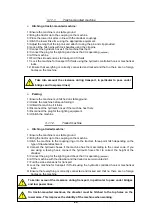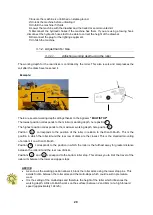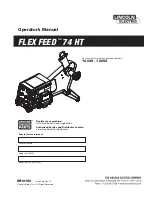
41
3.2.5.
Maintenance
- Hydraulic maintenance
Risk of infection caused by the oil in the hydraulic circuit penetrating the skin under high pressure.
Operations on the hydraulic circuit must only be performed by a specialised workshop.
Depressurise the hydraulic circuit completely before carrying out any operations on it.
Only use appropriate tools to look for leaks.
Under no circumstances must you try to stop a leak in the hydraulic hoses with your hand or
fingers.
Liquid leaking under high pressure (hydraulic oil) can penetrate the skin and cause serious
injury.
In case of injury caused by hydraulic oil, consult a doctor immediately. Risk of infection.
When connecting hydraulic hoses to the tractor's hydraulic circuit, ensure that the hydraulic
circuits on the tractor and machine are not under pressure.
Check that the hydraulic hoses are correctly connected.
Check regularly that hydraulic hoses and connections are in good condition and are clean.
Have the hydraulic hoses checked by a specialist at least once a year to ensure they are in
good condition.
Replace damaged or worn hydraulic hoses.
Only use genuine AGRISEM hydraulic hoses.
Hydraulic hoses must not be used for longer than six years, including a possible storage time
of two years maximum. Even under appropriate storage and usage conditions in line with the
permissible restrictions, it is completely normal for hoses and connectors to age, which is why
they have a limited storage time and service life. Nevertheless, the duration of use can be
established in line with empirical values, in particular taking into account potential risks. Other
reference values can be taken into consideration for thermoplastic hoses and pipes.
Dispose of used oil in accordance with current regulations. If this poses a problem, contact
your oil supplier.
Keep hydraulic oil out of reach of children.
Ensure that you do not contaminate the soil or water with hydraulic oil.
After 10 hours of service, and then every 50 hours of service
1. Check that all the components in the hydraulic circuit are sealed.
2. If necessary, tighten screwed connectors.
Before each time the machine is started
1. Visually check the hydraulic hoses for faults.
2. Remove any friction points on hydraulic hoses and tubes.
3. Replace damaged or worn hydraulic hoses immediately.
Inspection criteria for hydraulic hoses.
For your own safety, comply with the following inspection criteria.
Replace hydraulic hoses if you notice any of the following when examining them:
Deterioration of the outer layer down to the lining (e.g. friction points, cuts, splits).
Embrittlement of the outer layer (formation of cracks on the outer layer).
Distortions which do not correspond to the natural shape of the hose or pipe, whether or not
they are under pressure or under flexion (e.g. separation of the layers, bulges, crushed areas,
bending).
Areas that are leaking.
Damage or distortion of the end fitting (reducing sealing). Slight superficial damage does not
Содержание DS1100
Страница 2: ...2 ...
Страница 4: ...4 ...
Страница 6: ...6 ...
Страница 9: ...9 3 2 6 Disks 43 3 2 7 Lighting system 44 4 WARRANTLY CLARM FORM 45 ...
Страница 35: ...35 3 1 3 1 Seed metering table kg ha ...
Страница 45: ...45 ...
Страница 46: ...46 ...
Страница 47: ...47 ...
Страница 48: ...48 ...
Страница 49: ...49 ...

























